all text articles
Home > list > social
The Fire on Dragon Hill
Marco Giorgi
In the early morning hours of January 20th, a shipping container carrying members of the police SWAT team was hoisted to the roof of the Namildang building in Yongsan, a central district in the heart of Seoul City. The SWAT team used water canons to forcibly end a 25-hour long protest that was staged by local residents and members of the National Alliance of Squatters and Evictees. A fire soon engulfed the building. When the fire was finally extinguished at around 8 am that morning, six bodies were among the ashes; five protesters and one police officer.
The days that followed this tragedy left many asking what went wrong, what ignited the fire, and why such an incident took place?
The squatters assembled in the building the day before the fire to protest a compensation package they were offered in order to evacuate their homes and businesses to make room for a redevelopment project slated for the neighborhood. The protesters felt that the compensation packages were unfair and their voices were not being heard by the proper channels of authority.
Noh Han-na, a leader of the (Yongsan) 4th District squatters, was quoted in the online version of the LA Times on February 9th as saying, "People were indifferent to our plight, so they wanted to go up there and show their anger."
So, on January 19th, a little over 40 protestors, armed with Molotov cocktails, paint thinner, sling shots, and numerous other projectiles, entered the four-story building in the Yongsan district (which translates in English to Dragon Hill) and erected a makeshift watchtower on the roof to make their complaints heard.
Members of the police department and the ruling Grand National Party (GNP) point to the fact that the protesters came in armed, and that initiated the violent atmosphere that quickly began to brew. But, for anyone who has ever witnessed a protest in Seoul, whether large or small, could tell you that the riot police often outnumber the amount of protesters and are always overwhelmingly armed, hence the squatters being armed does not seem, to some, as violent, but actually as a means of being cautious against a violent police crackdown.
The police department mobilized 1,400 riot police and around 100 commandos (SWAT) after the protest began in order to end, what was at the moment, a peaceful protest. It wasn’t until the police were given the word to go in that the protesters felt compelled to defend themselves with their homemade weapons.
Did the protestors initiate the violence by being armed themselves, thus justifying the type of excessive police action that resulted on that tragic morning? Maybe, but probably not. An overwhelming part of the Korean public sees this as another example of the way Korean president Lee Myung-bak and his administration deal with dissenting voices in the street.
“This incident occurred due to a stringent and excessive crackdown, and is a tragedy that stems from President Lee’s style of public security control,” Democratic Party (DP) leader Chung Sye-kyun. (The Korea Herald, 1/22/2009)
Two days prior to this tragic incident in Yongsan, President Lee nominated Kim Seok-ki to become the commissioner-general of the National Police Agency. Kim was the Seoul Metropolitan Police Agency Chief at the time, and one of President Lee’s closest allies going back to the president’s time as Mayor of Seoul. Police Chief Kim is known for using a heavy-handed approach when dealing with protesters in the street.
It was only last year that Kim ordered the use of violence to finally dismantle the months-long candlelight protests that gripped the city. The candlelight protests were generally peaceful and attended by citizens of all ages and viewpoints, from high school girls to human rights activists to senior citizens. President Lee ordered a stop to those protests which were halting his young administration’s aspirations. Police Chief Kim ordered tear gas - which had not been used on the public since the days of military-backed dictatorships on the peninsula – and thousands of riot police to show that he could restore “law and order” quickly and decisively.
Many critics of the government’s handling of the recent events in Yongsan blamed Police Chief Kim for authorizing excessive force to end the sit-in, but some saw it as his way to flex his muscles before taking the post as the head of the National Police. The public quickly called for Kim to be relieved of duty and for the government to take responsibility for the incident.
"[Kim's] first performance after being appointed as the head of police was a bloody crackdown on ordinary citizens," a spokeswoman for the opposition Democratic Party said according to AFP news agency. (BBC News, 1/20/2009)
An investigation by the Seoul Central District Prosecutors’ Office was immediately launched, but was quickly criticized as being biased in favor of the government and the police department. The main opposition Democratic Party (DP) called for a parliamentary probe to look into the police crackdown, especially Police Chief Kim’s role, in Yongsan.
The ruling GNP quickly retorted this and blamed the DP for using the tragedy for political gain, since nominees like Kim Seok-ki and Won Sei-hoon, who was the minister of public administration and security at the time of the Yongsan fire and is slated to become director of the National Intelligence Service, were about to go before parliament for confirmation hearings prior to taking their new posts.
“The opposition party must not politically exploit the incident,” said GNP spokesman Yoon Sang-hyun. (The Korea Herald, 1/22/2009)
Two days after the fire that claimed six Korean lives, the Seoul Central District Prosecutors’ Office claimed that “… the victims died from the fire ignited by the makeshift bombs...”( The Korea Herald, 1/23/2009) “Their actions appeared to have motives other than an attempt to protect their livelihoods,” said Jeong Byeong-du, a senior prosecutor at the Seoul Central District Prosecutors’ Office. (JoongAng Daily, 1/23/2009) Immediately blaming the protesters for the fire without a thorough investigation led many to believe that this was the very beginning of what would become a 20-day investigation by the Prosecutors’ Office that would end in a bias and inconclusive way.
For one, critics claimed that the origin of the fire was still unknown. Some reports from witnesses stated that private security guards who were hired by the construction company started a fire on the lower floors of the building in an attempt to trap and smoke out the squatters. The Prosecutors’ Office and the government claimed that no private security was used in the operation on the morning of January 20th. They had to backtrack on this stance when an MBC television report showed video of private contractors spraying a water cannon at the protesters in the rooftop watchtower and holding shields while following behind a police line.
The Prosecutors’ Office said that they didn’t initially investigate this claim because the private security forces couldn’t be identified, thus justifying claims from critics that the investigation being conducted by the Prosecutors’ Office had too narrow a focus.
Police Chief Kim was also never summoned by the Prosecution to be interviewed about his role in the incident. Questions were sent via letter and he responded accordingly.
The calls for a more in-depth, unbiased probe went unanswered, and on February 9th the Prosecutors’ Office issued its investigation’s findings, which included the indictment of 27 people, including 20 of the protestors, for obstructing official duties. The police department and its leadership were cleared of any wrongdoing.
“The investigation, as we expected, put all the blame on the demonstrators and none on the police. The only option we have left now is to launch an independent council to get to the bottom of things,” the DP’s Roh Young-min. (The Korea Herald, 2/10/2009)
A day later, Kim Seok-ki withdrew his name for consideration to head the National Police Agency and urged the president to rescind his nomination as well. He called his stepping down a way of taking “moral responsibility” for what happened in Yongsan. This provided his critics with little comfort knowing that no one in the police department would be punished for what is perceived to be a blatant case of using excessive force.
One can be sure that the Prosecution’s findings will not be the end of pro- and anti-government factions bickering about what went wrong on that fateful day in January. But one thing is for sure, this tragedy could not have come at a worse time for President Lee and the ruling GNP.
The DP and other opposition parties, along with civic and human rights groups, used the Yongsan tragedy to spotlight Lee Myung-Bak and the ruling GNP’s controversial plan to push numerous reform bills through the National Assembly in February.
Candlelight vigils have been held every night at the construction site where the fire took place. Then on February 1st, civic groups and members of four opposition parties staged a rally in Cheonggye Plaza, near City Hall. The opposition parties wasted no time in connecting Yongsan to controversial laws supported by the GNP.
“Thirteen days have passed since the Yongsan incident, but the government has not taken any responsibility for it. Instead, it has declared a war against the people, particularly farmers and laborers, by trying to enact evil laws,” said DP Chairman Chung. (JoongAng Daily, 2/2/2009)
Although the GNP charged the opposition with playing “street politics,” the opposition was able to put public pressure on President Lee and his party.
The Yongsan incident has also lead many to question the nation’s land redevelopment laws. Many see the existing laws as heavily favoring the rich and dismissing the poor.
"They're focusing on profits and just casting these people aside," said Kim Nam-geun, a civil rights activist. "It's a push for development at any cost." (L.A. Times, 2/9/2009)
The ramifications of the Yongsan incident are continuing to play out on a daily basis. The Blue House (Korea’s equivalent to the White House) will be feeling the heat from the candles being relit every night in Yongsan and elsewhere around the country because of the events on the morning of January 20th. Only this time, Kim Seok-ki is not around to blow them out. President Lee, the “bulldozer,” will have to find a new way to put out the fires.
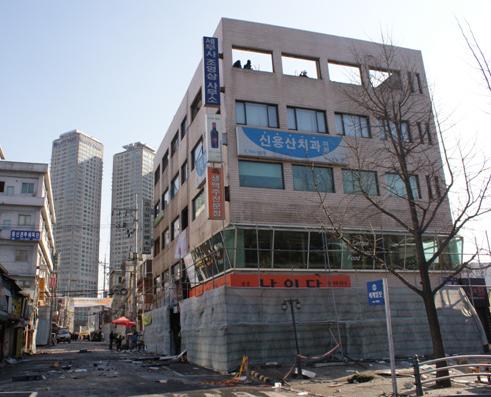 |
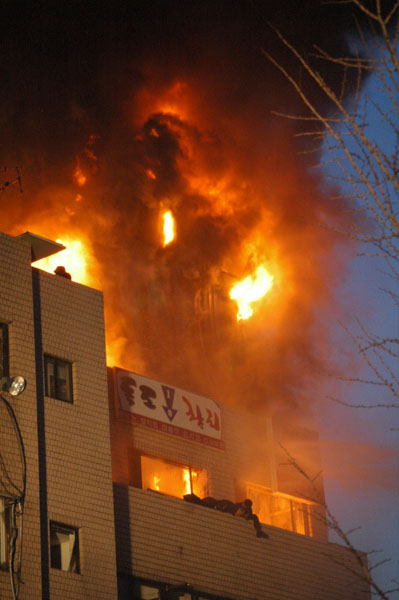 |
The days that followed this tragedy left many asking what went wrong, what ignited the fire, and why such an incident took place?
The squatters assembled in the building the day before the fire to protest a compensation package they were offered in order to evacuate their homes and businesses to make room for a redevelopment project slated for the neighborhood. The protesters felt that the compensation packages were unfair and their voices were not being heard by the proper channels of authority.
Noh Han-na, a leader of the (Yongsan) 4th District squatters, was quoted in the online version of the LA Times on February 9th as saying, "People were indifferent to our plight, so they wanted to go up there and show their anger."
So, on January 19th, a little over 40 protestors, armed with Molotov cocktails, paint thinner, sling shots, and numerous other projectiles, entered the four-story building in the Yongsan district (which translates in English to Dragon Hill) and erected a makeshift watchtower on the roof to make their complaints heard.
Members of the police department and the ruling Grand National Party (GNP) point to the fact that the protesters came in armed, and that initiated the violent atmosphere that quickly began to brew. But, for anyone who has ever witnessed a protest in Seoul, whether large or small, could tell you that the riot police often outnumber the amount of protesters and are always overwhelmingly armed, hence the squatters being armed does not seem, to some, as violent, but actually as a means of being cautious against a violent police crackdown.
The police department mobilized 1,400 riot police and around 100 commandos (SWAT) after the protest began in order to end, what was at the moment, a peaceful protest. It wasn’t until the police were given the word to go in that the protesters felt compelled to defend themselves with their homemade weapons.
Did the protestors initiate the violence by being armed themselves, thus justifying the type of excessive police action that resulted on that tragic morning? Maybe, but probably not. An overwhelming part of the Korean public sees this as another example of the way Korean president Lee Myung-bak and his administration deal with dissenting voices in the street.
“This incident occurred due to a stringent and excessive crackdown, and is a tragedy that stems from President Lee’s style of public security control,” Democratic Party (DP) leader Chung Sye-kyun. (The Korea Herald, 1/22/2009)
Two days prior to this tragic incident in Yongsan, President Lee nominated Kim Seok-ki to become the commissioner-general of the National Police Agency. Kim was the Seoul Metropolitan Police Agency Chief at the time, and one of President Lee’s closest allies going back to the president’s time as Mayor of Seoul. Police Chief Kim is known for using a heavy-handed approach when dealing with protesters in the street.
It was only last year that Kim ordered the use of violence to finally dismantle the months-long candlelight protests that gripped the city. The candlelight protests were generally peaceful and attended by citizens of all ages and viewpoints, from high school girls to human rights activists to senior citizens. President Lee ordered a stop to those protests which were halting his young administration’s aspirations. Police Chief Kim ordered tear gas - which had not been used on the public since the days of military-backed dictatorships on the peninsula – and thousands of riot police to show that he could restore “law and order” quickly and decisively.
Many critics of the government’s handling of the recent events in Yongsan blamed Police Chief Kim for authorizing excessive force to end the sit-in, but some saw it as his way to flex his muscles before taking the post as the head of the National Police. The public quickly called for Kim to be relieved of duty and for the government to take responsibility for the incident.
"[Kim's] first performance after being appointed as the head of police was a bloody crackdown on ordinary citizens," a spokeswoman for the opposition Democratic Party said according to AFP news agency. (BBC News, 1/20/2009)
An investigation by the Seoul Central District Prosecutors’ Office was immediately launched, but was quickly criticized as being biased in favor of the government and the police department. The main opposition Democratic Party (DP) called for a parliamentary probe to look into the police crackdown, especially Police Chief Kim’s role, in Yongsan.
The ruling GNP quickly retorted this and blamed the DP for using the tragedy for political gain, since nominees like Kim Seok-ki and Won Sei-hoon, who was the minister of public administration and security at the time of the Yongsan fire and is slated to become director of the National Intelligence Service, were about to go before parliament for confirmation hearings prior to taking their new posts.
“The opposition party must not politically exploit the incident,” said GNP spokesman Yoon Sang-hyun. (The Korea Herald, 1/22/2009)
Two days after the fire that claimed six Korean lives, the Seoul Central District Prosecutors’ Office claimed that “… the victims died from the fire ignited by the makeshift bombs...”( The Korea Herald, 1/23/2009) “Their actions appeared to have motives other than an attempt to protect their livelihoods,” said Jeong Byeong-du, a senior prosecutor at the Seoul Central District Prosecutors’ Office. (JoongAng Daily, 1/23/2009) Immediately blaming the protesters for the fire without a thorough investigation led many to believe that this was the very beginning of what would become a 20-day investigation by the Prosecutors’ Office that would end in a bias and inconclusive way.
For one, critics claimed that the origin of the fire was still unknown. Some reports from witnesses stated that private security guards who were hired by the construction company started a fire on the lower floors of the building in an attempt to trap and smoke out the squatters. The Prosecutors’ Office and the government claimed that no private security was used in the operation on the morning of January 20th. They had to backtrack on this stance when an MBC television report showed video of private contractors spraying a water cannon at the protesters in the rooftop watchtower and holding shields while following behind a police line.
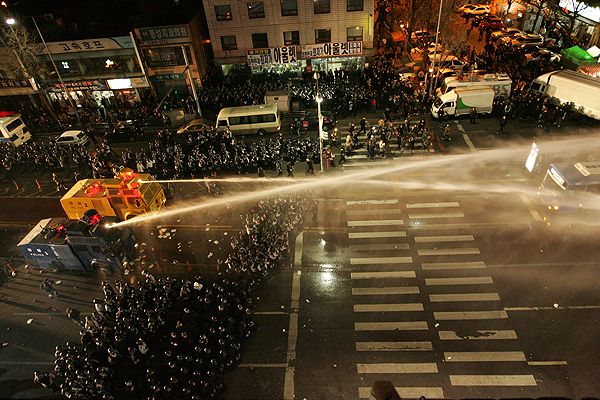 |
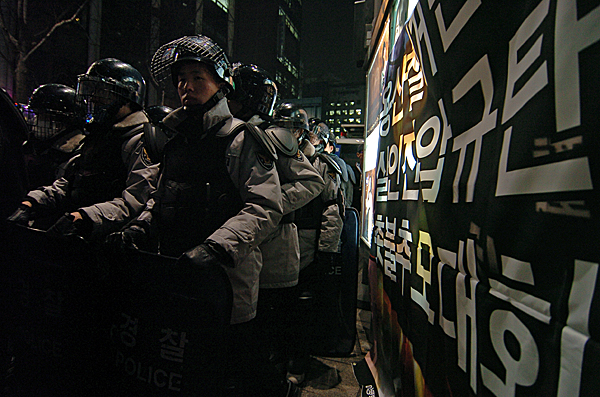 |
The Prosecutors’ Office said that they didn’t initially investigate this claim because the private security forces couldn’t be identified, thus justifying claims from critics that the investigation being conducted by the Prosecutors’ Office had too narrow a focus.
Police Chief Kim was also never summoned by the Prosecution to be interviewed about his role in the incident. Questions were sent via letter and he responded accordingly.
The calls for a more in-depth, unbiased probe went unanswered, and on February 9th the Prosecutors’ Office issued its investigation’s findings, which included the indictment of 27 people, including 20 of the protestors, for obstructing official duties. The police department and its leadership were cleared of any wrongdoing.
“The investigation, as we expected, put all the blame on the demonstrators and none on the police. The only option we have left now is to launch an independent council to get to the bottom of things,” the DP’s Roh Young-min. (The Korea Herald, 2/10/2009)
A day later, Kim Seok-ki withdrew his name for consideration to head the National Police Agency and urged the president to rescind his nomination as well. He called his stepping down a way of taking “moral responsibility” for what happened in Yongsan. This provided his critics with little comfort knowing that no one in the police department would be punished for what is perceived to be a blatant case of using excessive force.
One can be sure that the Prosecution’s findings will not be the end of pro- and anti-government factions bickering about what went wrong on that fateful day in January. But one thing is for sure, this tragedy could not have come at a worse time for President Lee and the ruling GNP.
The DP and other opposition parties, along with civic and human rights groups, used the Yongsan tragedy to spotlight Lee Myung-Bak and the ruling GNP’s controversial plan to push numerous reform bills through the National Assembly in February.
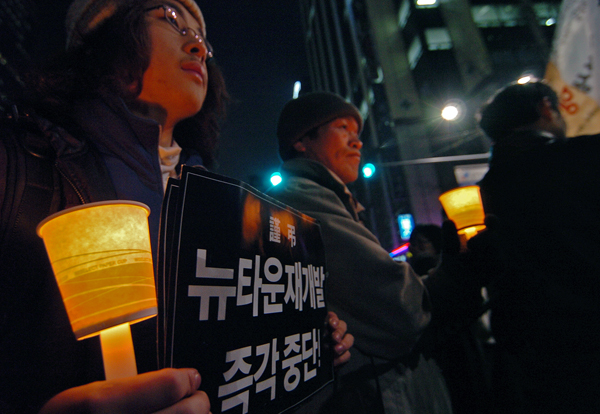 |
Candlelight vigils have been held every night at the construction site where the fire took place. Then on February 1st, civic groups and members of four opposition parties staged a rally in Cheonggye Plaza, near City Hall. The opposition parties wasted no time in connecting Yongsan to controversial laws supported by the GNP.
“Thirteen days have passed since the Yongsan incident, but the government has not taken any responsibility for it. Instead, it has declared a war against the people, particularly farmers and laborers, by trying to enact evil laws,” said DP Chairman Chung. (JoongAng Daily, 2/2/2009)
Although the GNP charged the opposition with playing “street politics,” the opposition was able to put public pressure on President Lee and his party.
The Yongsan incident has also lead many to question the nation’s land redevelopment laws. Many see the existing laws as heavily favoring the rich and dismissing the poor.
"They're focusing on profits and just casting these people aside," said Kim Nam-geun, a civil rights activist. "It's a push for development at any cost." (L.A. Times, 2/9/2009)
The ramifications of the Yongsan incident are continuing to play out on a daily basis. The Blue House (Korea’s equivalent to the White House) will be feeling the heat from the candles being relit every night in Yongsan and elsewhere around the country because of the events on the morning of January 20th. Only this time, Kim Seok-ki is not around to blow them out. President Lee, the “bulldozer,” will have to find a new way to put out the fires.
Real editing time : February 20, 2009
Registration : February 20, 2009
Registration : February 20, 2009
trackback URL http://www.newscham.net/news/trackback.php?board=news_E&nid=51741 [copyinClipboard]


